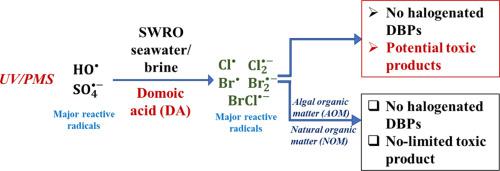Desalination ( IF 8.3 ) Pub Date : 2022-07-19 , DOI: 10.1016/j.desal.2022.115974 Abayomi Babatunde Alayande , Seungkwan Hong

|
The effects of discharged brine from desalination plants, particularly brine containing algal toxins during harmful agal bloom (HAB) occurrence, are a major concern for marine life and, as a result, human health. Therefore, removing algal toxins from desalination brine is critical for safeguarding both human health and the marine environment. The present work examined the mineralization of domoic acid (DA), an algal toxin, in highly concentrated seawater for the first time using an ultraviolet light activated peroxymonosulfate (UV/PMS) system. Mineralization efficiencies, effects of various anion concentrations, and reaction by-products were investigated. The presence of anions such as chloride, bromide, and bicarbonate reduces the mineralization efficiency of the UV/PMS system, with bromide being the most detrimental. Although DA can be effectively degraded in synthetic seawater (35,000 ppm), total mineralization is not possible within 180 min of reaction time, with only 38.4 %, 44.8 %, and 41 % TOC removal in pH 3, 5, and 7, respectively, when 1 mM of PMS was used. Analyses of treated hypersaline seawater using ultra-high-resolution liquid chromatography coupled with quadrupole time-of-flight mass spectrometry and ion chromatography revealed that DA was completely degraded in synthetic seawater and that, in the presence of algal organic matter, no toxic by-product was generated during the detoxification process. Overall, the UV/PMS system has the potential to be an effective treatment strategy for algal toxins in seawater during HAB events in the SWRO desalination process.
中文翻译:

基于硫酸根的高级氧化工艺用于海水淡化中的藻毒素矿化
海水淡化厂排放的盐水,尤其是在有害藻华 (HAB) 发生期间含有藻类毒素的盐水的影响是海洋生物的主要关注点,因此也影响人类健康。因此,去除海水淡化盐水中的藻类毒素对于保护人类健康和海洋环境至关重要。目前的工作首次使用紫外光激活的过氧单硫酸盐 (UV/PMS) 系统检查了高浓度海水中藻类毒素软骨藻酸 (DA) 的矿化。研究了矿化效率、各种阴离子浓度的影响和反应副产物。氯离子、溴离子和碳酸氢根等阴离子的存在会降低 UV/PMS 系统的矿化效率,其中溴离子是最有害的。尽管 DA 可以在合成海水 (35,000 ppm) 中有效降解,但在 180 分钟的反应时间内不可能完全矿化,在 pH 3、5 和 7 下,TOC 分别仅去除 38.4%、44.8% 和 41%,当使用 1 mM PMS 时。使用超高分辨率液相色谱结合四极杆飞行时间质谱和离子色谱对处理过的高盐海水进行分析表明,DA 在合成海水中完全降解,并且在存在藻类有机物的情况下,无毒性产品是在解毒过程中产生的。总体而言,UV/PMS 系统有可能成为 SWRO 淡化过程中 HAB 事件期间海水中藻类毒素的有效处理策略。在反应时间 180 分钟内不可能完全矿化,当使用 1 mM PMS 时,在 pH 3、5 和 7 中,TOC 的去除率分别仅为 38.4%、44.8% 和 41%。使用超高分辨率液相色谱结合四极杆飞行时间质谱和离子色谱对处理过的高盐海水进行分析表明,DA 在合成海水中完全降解,并且在存在藻类有机物的情况下,无毒性产品是在解毒过程中产生的。总体而言,UV/PMS 系统有可能成为 SWRO 淡化过程中 HAB 事件期间海水中藻类毒素的有效处理策略。在反应时间 180 分钟内不可能完全矿化,当使用 1 mM PMS 时,在 pH 3、5 和 7 中,TOC 的去除率分别仅为 38.4%、44.8% 和 41%。使用超高分辨率液相色谱结合四极杆飞行时间质谱和离子色谱对处理过的高盐海水进行分析表明,DA 在合成海水中完全降解,并且在存在藻类有机物的情况下,无毒性产品是在解毒过程中产生的。总体而言,UV/PMS 系统有可能成为 SWRO 淡化过程中 HAB 事件期间海水中藻类毒素的有效处理策略。使用超高分辨率液相色谱结合四极杆飞行时间质谱和离子色谱对处理过的高盐海水进行分析表明,DA 在合成海水中完全降解,并且在存在藻类有机物的情况下,无毒性产品是在解毒过程中产生的。总体而言,UV/PMS 系统有可能成为 SWRO 淡化过程中 HAB 事件期间海水中藻类毒素的有效处理策略。使用超高分辨率液相色谱结合四极杆飞行时间质谱和离子色谱对处理过的高盐海水进行分析表明,DA 在合成海水中完全降解,并且在存在藻类有机物的情况下,无毒性产品是在解毒过程中产生的。总体而言,UV/PMS 系统有可能成为 SWRO 淡化过程中 HAB 事件期间海水中藻类毒素的有效处理策略。











































 京公网安备 11010802027423号
京公网安备 11010802027423号